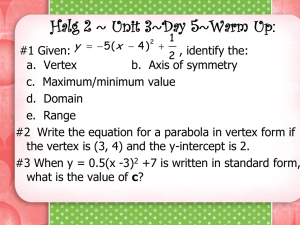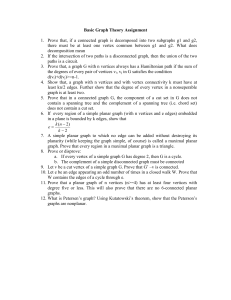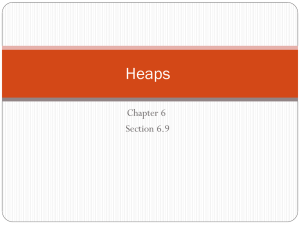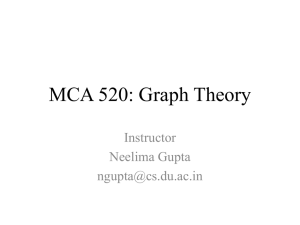Problem Set 4
advertisement
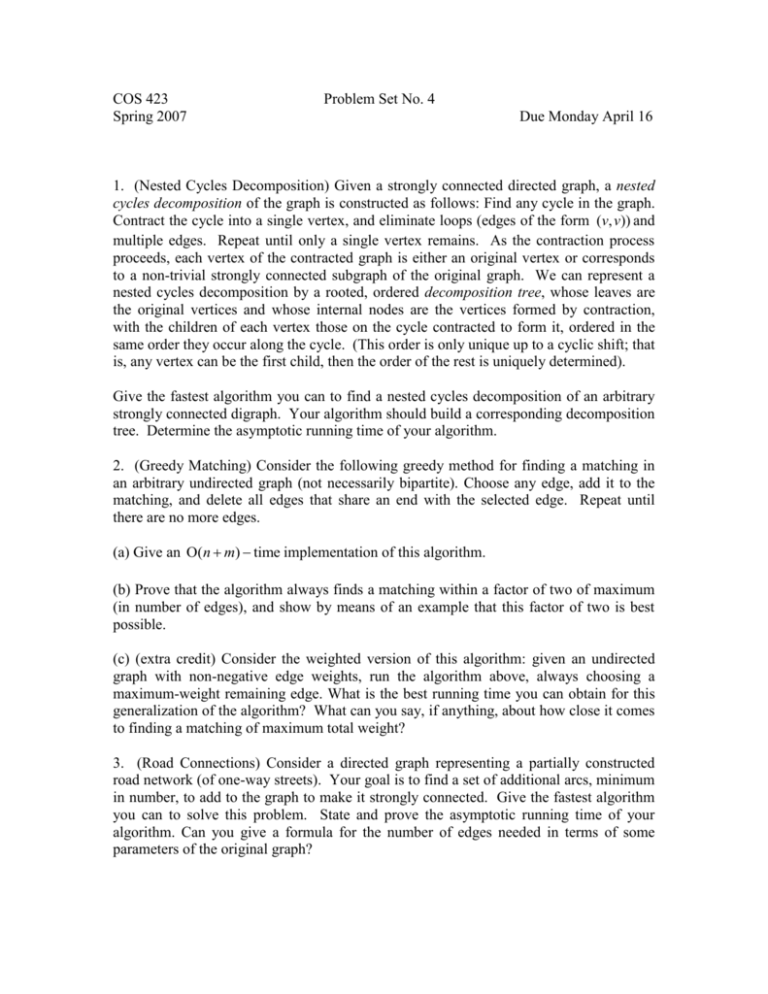
COS 423 Spring 2007 Problem Set No. 4 Due Monday April 16 1. (Nested Cycles Decomposition) Given a strongly connected directed graph, a nested cycles decomposition of the graph is constructed as follows: Find any cycle in the graph. Contract the cycle into a single vertex, and eliminate loops (edges of the form (v, v)) and multiple edges. Repeat until only a single vertex remains. As the contraction process proceeds, each vertex of the contracted graph is either an original vertex or corresponds to a non-trivial strongly connected subgraph of the original graph. We can represent a nested cycles decomposition by a rooted, ordered decomposition tree, whose leaves are the original vertices and whose internal nodes are the vertices formed by contraction, with the children of each vertex those on the cycle contracted to form it, ordered in the same order they occur along the cycle. (This order is only unique up to a cyclic shift; that is, any vertex can be the first child, then the order of the rest is uniquely determined). Give the fastest algorithm you can to find a nested cycles decomposition of an arbitrary strongly connected digraph. Your algorithm should build a corresponding decomposition tree. Determine the asymptotic running time of your algorithm. 2. (Greedy Matching) Consider the following greedy method for finding a matching in an arbitrary undirected graph (not necessarily bipartite). Choose any edge, add it to the matching, and delete all edges that share an end with the selected edge. Repeat until there are no more edges. (a) Give an O(n m) time implementation of this algorithm. (b) Prove that the algorithm always finds a matching within a factor of two of maximum (in number of edges), and show by means of an example that this factor of two is best possible. (c) (extra credit) Consider the weighted version of this algorithm: given an undirected graph with non-negative edge weights, run the algorithm above, always choosing a maximum-weight remaining edge. What is the best running time you can obtain for this generalization of the algorithm? What can you say, if anything, about how close it comes to finding a matching of maximum total weight? 3. (Road Connections) Consider a directed graph representing a partially constructed road network (of one-way streets). Your goal is to find a set of additional arcs, minimum in number, to add to the graph to make it strongly connected. Give the fastest algorithm you can to solve this problem. State and prove the asymptotic running time of your algorithm. Can you give a formula for the number of edges needed in terms of some parameters of the original graph? 4. (Live Vertex Preflow Push Algorithm) Consider the following modification of the preflow push algorithm. A vertex v is live if, for every distance k such that d (v) k 0, there is at least one vertex w with d ( w) k . (Here d (u ) is the distance label of vertex u.) The live vertex preflow push algorithm is the variant of the preflow push algorithm that discharges an active live vertex of highest distance label, stopping the discharge of such a vertex as soon as it becomes dead (because of an increase in its distance label) and setting its distance label equal to n. (a) Prove (i) every live vertex has label less than n, and thus (ii) there are no pushes from live to dead vertices and (iii) no dead vertex ever becomes live. (b) Prove that when the algorithm stops, the cut whose source side is the set of dead vertices is a minimum cut. (c) When the algorithm stops, there may still be (dead) vertices that are active. Give an example. Describe the fastest algorithm you can that will convert the final preflow into a maximum flow (by routing the remaining excess back to the source). (An O(nm) time solution will suffice. The fastest solution I know is O(m log n) time, but it uses a data structure we have not discussed in class.) (d) Describe a way to implement the algorithm so that the overhead to keep track of the live and dead vertices, and to select vertices to discharge, is O(1) per relabeling (by one) of a vertex. (e) Prove that the algorithm runs in O(n3 ) time. (f) (extra credit) Is the O(n3 ) bound tight, or can you obtain a better bound?

